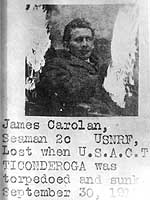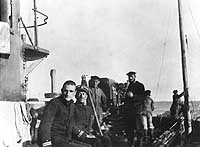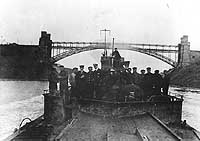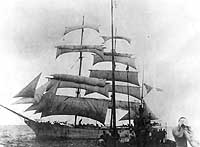
USS Ticonderoga, a 5130 gross ton cargo ship and animal transport, was built at Bremerhaven, Germany in 1914 as the German flag merchant steamer Kamilla Rickmers. Seized by the U.S. Government in 1917, she was renamed Ticonderoga later in that year, turned over to the Navy under charter and placed in commission in early January 1918. Later in that month she loaded cargo and, during February and March, made her initial voyage to France and back. Two more such round-trips followed in May-June and July-September 1918. On 27 August, while homeward-bound, she was unsuccessfully attacked by German submarine gunfire.
Ticonderoga left New York for her fourth trip to France on 22 September 1918, but experienced machinery problems that caused her to drop behind her convoy during the night of 29-30 September. At about 5:45 in the morning of the 30th, a submarine was spotted ahead. As the ship's gun crews prepared for action, her Commanding Officer, Lieutenant Commander James J. Madison, tried to ram the enemy, but narrowly missed. The German, the large and heavily-armed cruiser submarine U-152, opened fire and hit Ticonderoga hard, setting her ablaze, killing several men, temporarily disabling her helm and knocking out her forward gun. With her radio wrecked, she was unable to call for help and had to continue the contest unsupported. Though badly wounded, LCdr. Madison regained his position on the bridge, got the ship under control and turned so her after gun, a six-inch, could bear on the enemy. U-152 submerged, then returned to the surface and resumed the battle. Once Ticonderoga's after gun was put out of commission, she was relentlessly pounded by exploding shells from the submarine's two 15cm (5.9-inch) deck guns.
Casualties among Ticonderoga's crew and passengers were very heavy. Unable to steer and incapable of fighting back, she was now helpless. U-152 took position off the American ship's starboard beam and fired a torpedo that hit just aft of her engine room. Ticonderoga began to sink. Most of her lifeboats were full of holes and others swamped on launching, leaving only one boat and a raft for her survivors. As the ship was being abandoned under a white flag, the submarine continued to fire, killing and wounding even more men. After Ticonderoga had sunk, U-152 approached in search of officers, finally capturing her Executive Officer, Lieutenant Frank Muller, and Lieutenant (Junior Grade) Junius Fulcher. The remaining men, among them the gravely injured Lieutenant Commander Madison, were left adrift. After four days, the British freighter Moorish Prince came upon them, rescuing the twenty-two still alive. Those, plus the two officers taken by U-152, were the only survivors of the 237 on board Ticonderoga when the battle began. The dead included 112 U.S. Sailors and 101 Soldiers. This was the greatest combat loss of life on any U.S. Navy ship during the First World War. Only the Coast Guard Cutter Tampa, sunk a few days earlier, had more Naval personnel killed by hostile action. The 309 lost with the collier Cyclops, which disappeared in March 1918, were probably the victims of an accident.
This page features all the views we have concerning USS Ticonderoga (ID # 1958).
For other images related to this ship, see:
| If you want higher resolution reproductions than the digital images presented here, see: "How to Obtain Photographic Reproductions." |
Click on the small photograph to prompt a larger view of the same image.
|
Photo #: NH 42415 S.S. Ticonderoga (German-American Freighter, 1914) At Boston, Massachusetts, 27 November 1917. Built in 1914 as the German flag merchant steamer Kamilla Rickmers, and seized when the United States entered World War I, this ship was renamed Ticonderoga in August 1917. She was placed in commission as USS Ticonderoga (ID # 1958) on 5 January 1918, and sunk, with the loss of 213 lives, by the German submarine U-152 on 30 September 1918. Also present, at far left, is USS Albany (1900-1930). Three section patrol (SP) boats are partially visible at the far right. U.S. Naval Historical Center Photograph. Online Image: 49KB; 740 x 515 pixels |
 |
|
Photo #: NH 103637-KN (color) USS Ticonderoga (ID # 1958) Clipping from a newspaper published circa 10 October 1918, providing an account of the ship's sinking with great loss of life. This clipping, containing only part of the original article, was mounted on one of the ship's Navy data cards, the reverse side of which featured the original print for Photo # NH 42415. U.S. Naval Historical Center Photograph. Online Image: 64KB; 225 x 765 pixels |
 |
|
Photo #: NH 50616 Seaman Second Class James Carolan, USNRF Who lost his life when USS Ticonderoga (ID # 1958) was sunk in combat with the German submarine U-152, 30 September 1918. U.S. Naval Historical Center Photograph. Online Image: 81KB; 555 x 765 pixels |
 |
|
Photo #: NH 2472 U-152 (German Submarine, 1917) View on deck during a combat cruise in the Atlantic, 16 October 1918. Seated in the left center foreground are two U.S. Navy officers captured when the submarine sank USS Ticonderoga (ID # 1958) on 30 September 1918. They are Lieutenant Frank L. Muller, USNRF, Ticonderoga's Executive Officer (at left), and Lieutenant (Junior Grade) Junius H. Fulcher, USNRF. The others present are members of U-152's crew. U.S. Naval Historical Center Photograph. Online Image: 67KB; 740 x 570 pixels |
 |
|
Photo #: NH 44371 U-152 (German Submarine, 1917) Officers, crewmen and their U.S. Navy prisoners of war on the submarine's deck, as she arrived at Kiel, Germany, 15 November 1918. The two U.S. Navy officers, captured when the U-152 sank USS Ticonderoga (ID # 1958) on 30 September 1918, are in the left portion of this photograph. Lieutenant (Junior Grade) Junius H. Fulcher, USNRF, is wearing his USN Officer's cap, and stands directly behind the bearded man in the left foreground. By his left shoulder, wearing a civilian cap, is Lieutenant Frank L. Muller, USNRF, Ticonderoga's Executive Officer. U.S. Naval Historical Center Photograph. Online Image: 75KB; 740 x 550 pixels |
 |
|
Photo #: NH 41767 U-152 (German Submarine, 1917) Officers, crewmen and a former prisoner of war on the submarine's foredeck, while she was passing through the Kiel Canal on the way to Harwich, England to be surrendered, 28 November 1918. Two U.S. Navy officers, captured when the U-152 sank USS Ticonderoga (ID # 1958) on 30 September 1918, were on board the submarine. One is seen in this photograph, standing third from right, wearing his uniform and a civilian cap. He is Lieutenant Frank L. Muller, USNRF, Ticonderoga's Executive Officer. The other was Lieutenant (Junior Grade) Junius H. Fulcher, USNRF. U.S. Naval Historical Center Photograph. Online Image: 69KB; 740 x 545 pixels |
 |
|
Photo #: NH 2473 U-152 (German Submarine, 1917) Comes alongside its prize, the Norwegian bark Stifinder, on 13 October 1918. The bark was sunk after being captured in the western mid-Atlantic. She appears to be flying a Spanish flag. At this time U-152 had two U.S. Navy officers on board as prisoners of war, captured when she sank USS Ticonderoga (ID # 1958) on 30 September 1918. They were Lieutenant Frank L. Muller, USNRF, Ticonderoga's Executive Officer, and Lieutenant (Junior Grade) Junius H. Fulcher, USNRF. U.S. Naval Historical Center Photograph. Online Image: 61KB; 740 x 570 pixels |
 |
| If you want higher resolution reproductions than the digital images presented here, see: "How to Obtain Photographic Reproductions." |
Page made 26 September 2006